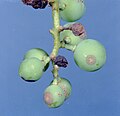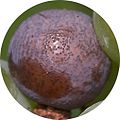Black rot of the vine
| Black rot of the vine | ||||||||||||
|---|---|---|---|---|---|---|---|---|---|---|---|---|

Black rot of the vine ( Guignardia bidwellii ) |
||||||||||||
| Systematics | ||||||||||||
|
||||||||||||
| Scientific name | ||||||||||||
| Guignardia bidwellii | ||||||||||||
| ( Ellis ) Viala & Ravaz |
The filamentous fungus Guignardia bidwellii ( Anamorphic : Phyllosticta ampelicida (Engleman) van der Aa) calls the fungal disease black rot ( english Black red ) out. The black rot only spreads in mild and humid weather. It can cause yield losses of 5 to 80%.
distribution
The disease, which originally only occurred in the USA and Canada , was spread around the world with infected plant material.
The disease was first described by André Michaux at the end of the 18th century . However, it did not cause a sensation until 1848, when it brought viticulture in Ohio to an almost complete standstill, at least in the south. After the black rot found ideal conditions in South America, it has been known in Europe since 1885.
On September 7, 1885, Viala and Ravaz published the first occurrence of the disease in France . Damaged plants were discovered in Cazilhac near Ganges . Since then, the fungus has appeared regularly in some areas of France and Italy and, since 1989, in the canton of Ticino in Switzerland . In Germany, the disease already appeared in the Baden wine-growing region in 1933 , but severe infestation has only been observed in the Moselle , Nahe and Middle Rhine regions since 2002 . Organically managed vineyards are particularly hard hit.
biology
The fungus can overwinter in many parts of the plant on the vine, often and often in so-called 'mummies' (dried grapes). During the winter, fruiting bodies form, from which ascospores are produced sexually . Even with little rainfall, these are expelled in spring and spread by the wind. However, they need moisture and higher temperatures to germinate. The optimal germination temperature is 26.5 ° C with a germination time of 6 hours. The ascospores can infect both the foliage and all other green parts of the plant. Within a few days, asexual spores in so-called pycnidia form in the infected and dead parts of the plant , which in turn can lead to further infections. As a rule, the risk of infection for the vine remains until it begins to ripen. The risk of infection only decreases when the plant stops growing and the temperatures usually fall.
Clinical picture
The leaves show spots no more than 9 mm in size, which are separated from healthy tissue by a dark brown border. Blackish necroses form on the summer shoots. Infested berries turn dark gray and usually dry completely (fruit mummies).
Shoot infestation, infestation with pycnidia
Combat
Infested reorganisms are to be removed from the vineyards as an initial inoculum for further infections. Furthermore, dries that are no longer cultivated must be consequently cleared. In integrated viticulture, plant protection products from the active ingredient classes of strobilurins , triazoles and dithiocarbamates have proven to be very effective. Black rot poses a particular problem in organic viticulture. The basis for a successful black rot control strategy is based on cultural measures. Of the direct control measures, the weekly use of the combination of sulfur and copper has proven to be the most effective.
literature
- Jancis Robinson : The Oxford Wine Lexicon . Hallwag, Gräfe and Unzer, Munich 2006, ISBN 3-8338-0691-5 .
- Pierre Galet : Les maladies et les parasites de la vigne . tape 1 . Imprimerie du Paysan du Midi, Montpellier 1977, ISBN 2-87777-038-9 .
- Daniel Molitor: Studies on the biology and control of black rot (Guignardia bidwellii) on grapevines (= Geisenheimer reports . Volume 65 ). Geisenheim 2009, ISBN 978-3-934742-54-3 .
- Karl Bauer, Ferdinand Regner , Barbara Schildberger: Viticulture . 9th edition. avBook published by Cadmos Verlag, Vienna 2013, ISBN 978-3-7040-2284-4 .
- Horst Diedrich Mohr (Hrsg.): Color atlas diseases, pests and beneficial insects on the grapevine . Eugen Ulmer, Stuttgart 2005, ISBN 3-8001-4148-5 .
Web links
- Black rot of the vine - Rebschutzdienst Lower Austria
Individual evidence
- ^ J. Hallmann, A. Quadt-Hallmann, A. von Tiedemann: Phytomedizin . Verlag Eugen Ulmer, Stuttgart 2007, ISBN 978-3-8252-2863-7 .
- ^ Karl Bauer, Ferdinand Regner, Barbara Schildberger: Viticulture. 9th edition. avBook published by Cadmos Verlag, Vienna 2013, ISBN 978-3-7040-2284-4 , pp. 369-370.
- ^ Karl Bauer, Ferdinand Regner, Barbara Schildberger: Viticulture. 9th edition. avBook published by Cadmos Verlag, Vienna 2013, ISBN 978-3-7040-2284-4 , pp. 369-370.


















